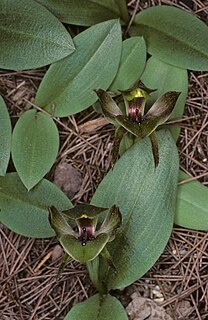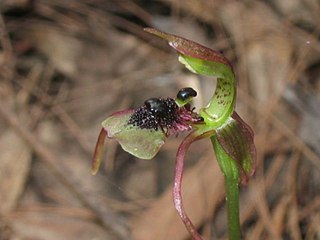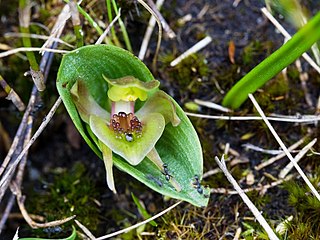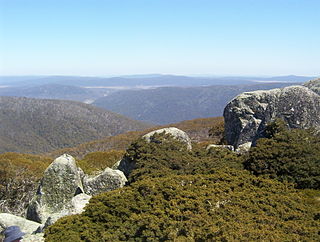
Caladenia moschata, commonly known as musky caps or musky caladenia, is a plant in the orchid family Orchidaceae and is endemic to eastern and south-eastern Australia, including Tasmania. It is a ground orchid with a single leaf and up to five flowers which are dark-coloured on the back and white on the front, sometimes tinged with pink and with a strong musky or soapy odour. The species was previously known as Caladenia gracilis.
Genoplesium validum, commonly known as the Blackdown midge orchid, is a small terrestrial orchid endemic to the Blackdown Tableland National Park in Queensland. It has a single thin leaf fused to the flowering stem and up to thirty five greenish-brown flowers with reddish stripes and a hairy labellum.
Chiloglottis anaticeps, commonly known as the duck's-head wasp orchid or bird orchid is a species of orchid endemic to the New England Tableland of New South Wales. It has two narrow leaves and a single greenish brown or reddish flower with a shiny, dark green callus occupying most of the top of the labellum. One end of the callus looks like a tiny duck's head.
Chiloglottis chlorantha, commonly known as the Wollongong bird orchid, is a species of orchid endemic to a small part of New South Wales. It has two broad leaves and a single green to yellowish green flower with about twelve reddish, yellowish or bright green glands on the labellum callus.

Chiloglottis cornuta, commonly known as the green bird orchid, is a species of orchid found in south-eastern Australia and in New Zealand including many of its offshore islands. It has two broad leaves and a single green or pinkish flower with six to eight rounded, green, reddish or blackish calli on the labellum.
Chiloglottis grammata, commonly known as the small bird orchid, is a species of orchid endemic to Tasmania. It has two broad leaves and a single greenish purple to purple flower with short, shiny greenish to reddish or black calli and low ridges resembling writing, covering most of the upper surface of the labellum. It is widespread and common in high rainfall mountainous areas.

Chiloglottis gunnii, commonly known as the tall bird orchid, is a species of orchid endemic to Tasmania. It has two broad leaves and a single green to purplish brown flower with a line of erect calli with swollen heads along the mid-line of the labellum. It is widespread but mainly in coastal districts and most commonly in moist to wet forest.

Chiloglottis jeanesii, commonly known as the mountain bird orchid, is a species of orchid endemic to Victoria. It has two broad leaves and a single green to dark purplish brown flower with shiny black, column-like calli on the labellum.
Chiloglottis palachila, commonly known as the spade-lipped wasp orchid, is a species of orchid endemic to some of the higher places in northern New South Wales. It has two leaves and a single green to greenish pink flower with a black, ant-like callus on the base of the labellum. The tips of the lateral sepals have distinctive swollen, brown glandular tips.
Chiloglottis × pescottiana, commonly known as the bronze bird orchid, is a species of orchid endemic to south-eastern Australia. It has two broad leaves and a single greenish bronze or purplish brown flower with a black, ant-like callus on the labellum. It is a natural hybrid formed from a cross between Chiloglottis valida and C. trapeziformis.
Chiloglottis platyptera, commonly known as the winged ant orchid or Barrington Tops ant orchid, is a species of orchid endemic to the New England Tableland of New South Wales. It has two broad leaves and a single greenish brown flower with a callus of many glands covering most of the top of the labellum.
Chiloglottis pluricallata, commonly known as the clustered bird orchid, is a species of orchid endemic to the New England Tableland and Barrington Tops in New South Wales. It has two broad leaves and a single reddish to purplish brown flower with a callus of about six pairs of reddish to blackish glands covering two-thirds of the top of the labellum.

Chiloglottis reflexa, commonly known as the short-clubbed wasp orchid, is a species of orchid endemic to the south-eastern Australia. It has two broad leaves and a single greenish-bronze or purplish flower with an ant-like callus covering most of the top of the labellum.

Chiloglottis seminuda, commonly known as the turtle orchid, is a species of orchid endemic to south-eastern New South Wales. It has two broad leaves and a single green or reddish pink flower with a shiny black insect-like callus covering two-thirds of the base of the labellum but with the tip of the labellum free of callus.
Chiloglottis sphaerula is a species of orchid endemic to a small part of New South Wales. It has two dark green leaves and a single green to reddish pink flower with a shiny black insect-like callus covering two-thirds of the base of the labellum but with the tip of the labellum free of callus.
Chiloglottis sphyrnoides, commonly known as the forest wasp orchid, is a species of orchid endemic to north-eastern New South Wales and south-eastern Queensland. It has two dark green leaves and a single green or reddish pink flower with a shiny black, insect-like callus surrounded by red club-shaped calli on two-thirds of the base of the labellum.

Chiloglottis sylvestris, commonly known as the small wasp orchid, is a small, delicate species of orchid endemic to eastern Australia. It has two dark green leaves and a single greenish pink flower with a reddish black, insect-like callus surrounded by fine, radiating, red, club-shaped calli on two-thirds of the base of the labellum.

Chiloglottis trapeziformis, commonly known as the broad-lip bird orchid, diamond ant orchid or dainty bird-orchid, is a species of orchid endemic to south-eastern Australia. It has two narrow leaves and a narrow, greenish to purplish or brownish flower with a short, shiny black, ant-like callus covering the lower quarter of the diamond-shaped labellum. It has been recorded as a vagrant in New Zealand.

Chiloglottis triceratops, commonly known as the three-horned bird orchid,, is a species of orchid endemic to Tasmania. It has two broad leaves and a greenish brown to purplish brown flower with a few column-like calli near the mid-line of the labellum.

Chiloglottis turfosa, commonly known as the bog bird orchid, is a species of orchid endemic to southern New South Wales and the Australian Capital Territory. It has two dark green leaves and a single greenish to reddish brown flower with a shiny dark reddish callus of mostly thin, column-like glands on the labellum.





















